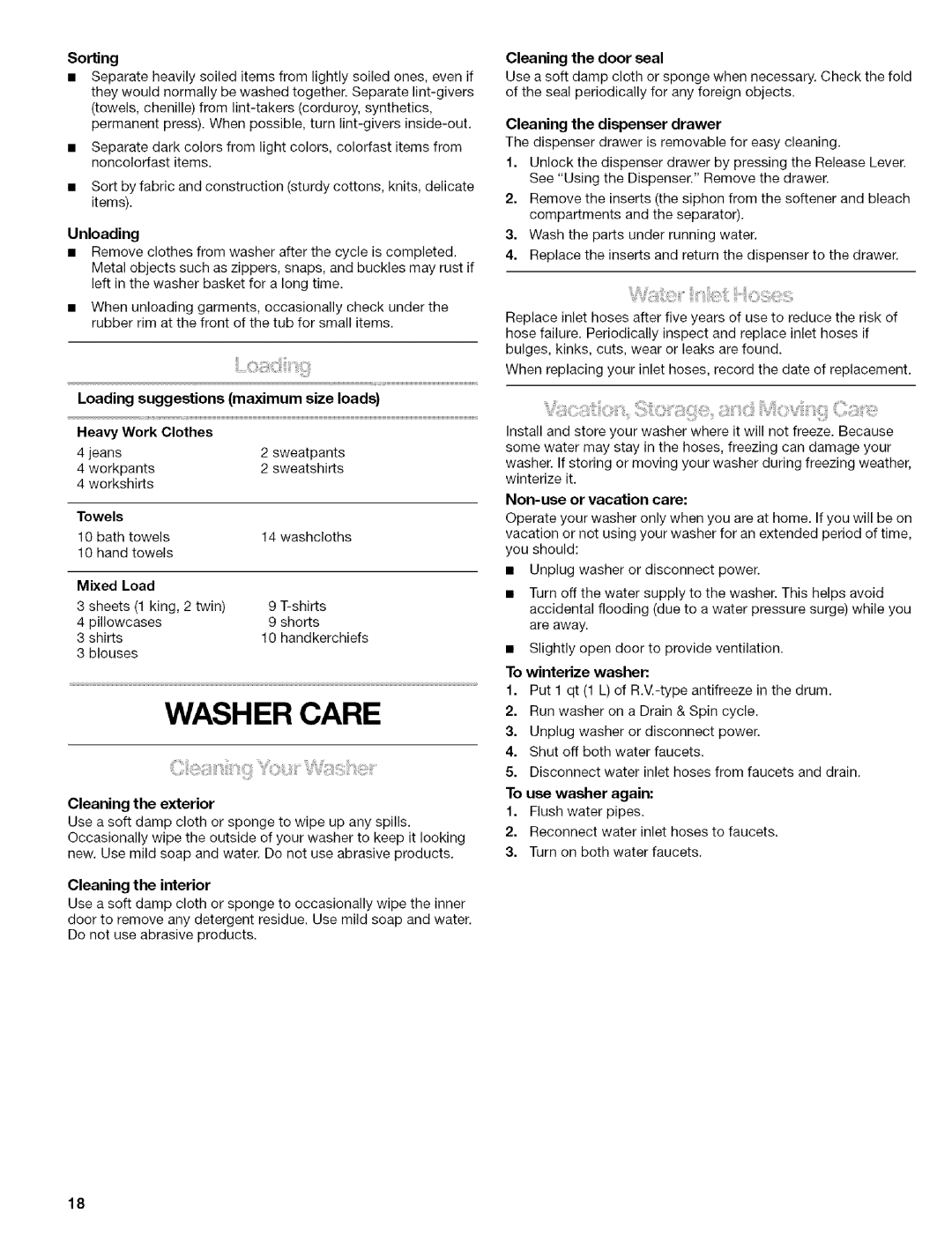
Sorting
•Separate heavily soiled items from lightly soiled ones, even if they would normally be washed together. Separate
•Separate dark colors from light colors, colorfast items from noncolorfast items.
•Sort by fabric and construction (sturdy cottons, knits, delicate items).
Unloading
•Remove clothes from washer after the cycle is completed. Metal objects such as zippers, snaps, and buckles may rust if left in the washer basket for a long time.
•When unloading garments, occasionally check under the rubber rim at the front of the tub for small items.
Loading suggestions (maximum size loads)
Heavy Work Clothes |
| |
4 jeans |
| 2 sweatpants |
4 workpants | 2 sweatshirts | |
4 workshirts |
| |
Towels |
|
|
10 bath | towels | 14 washcloths |
10 hand | towels |
|
Mixed Load |
| |
3 sheets | (1 king, 2 twin) | 9 |
4 pillowcases | 9 shorts | |
3 shirts |
| 10 handkerchiefs |
3 blouses |
| |
WASHER CARE
Cleaning the exterior
Use a soft damp cloth or sponge to wipe up any spills. Occasionally wipe the outside of your washer to keep it looking new. Use mild soap and water. Do not use abrasive products.
Cleaning the interior
Use a soft damp cloth or sponge to occasionally wipe the inner door to remove any detergent residue. Use mild soap and water. Do not use abrasive products.
Cleaning the door seal
Use a soft damp cloth or sponge when necessary. Check the fold of the seal periodically for any foreign objects.
Cleaning the dispenser drawer
The dispenser drawer is removable for easy cleaning.
1.Unlock the dispenser drawer by pressing the Release Lever. See "Using the Dispenser." Remove the drawer.
2.Remove the inserts (the siphon from the softener and bleach compartments and the separator).
3.Wash the parts under running water.
4.Replace the inserts and return the dispenser to the drawer.
Replace inlet hoses after five years of use to reduce the risk of hose failure. Periodically inspect and replace inlet hoses if bulges, kinks, cuts, wear or leaks are found.
When replacing your inlet hoses, record the date of replacement.
Install and store your washer where it will not freeze. Because some water may stay in the hoses, freezing can damage your washer. If storing or moving your washer during freezing weather, winterize it.
Non-use or vacation care:
Operate your washer only when you are at home. If you will be on vacation or not using your washer for an extended period of time, you should:
•Unplug washer or disconnect power.
•Turn off the water supply to the washer. This helps avoid accidental flooding (due to a water pressure surge) while you are away.
•Slightly open door to provide ventilation.
To winterize washer:
1.Put 1 qt (1 L) of
2.Run washer on a Drain & Spin cycle.
3.Unplug washer or disconnect power.
4.Shut off both water faucets.
5.Disconnect water inlet hoses from faucets and drain.
To use washer again:
1.Flush water pipes.
2.Reconnect water inlet hoses to faucets.
3.Turn on both water faucets.
18
